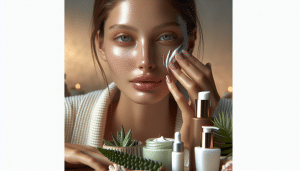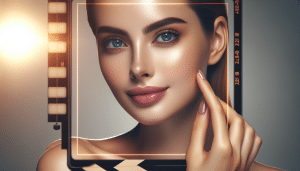Signs You Might Be Missing Healthy Skin Secrets
Natalie Brooks September 5, 2025
Many people wonder what really keeps skin radiant and resilient. This guide explores unexpected habits, underlying factors, and wellness routines that can unlock natural beauty. Discover the tips, ingredients, and routines that help reveal glowing, healthier-looking skin.
Everyday Habits That Affect Skin Wellness
Daily routines influence the health of skin far more than most realize. Even short nighttime rituals, such as consistent cleansing before bed, can impact how the skin repairs itself overnight. Environmental stressors, like pollution and blue light from screens, subtly build up and can alter surface texture and tone over time. Being mindful of not only what you apply topically, but also your lifestyle choices, lays a foundation for lasting radiance and youthful appearance. Simple steps like using gentle cleansers, removing makeup fully, and keeping hands away from your face promote a cleaner, more balanced complexion.
Nutrition, often overlooked, plays a pivotal role in skin appearance and function. Diets enriched with antioxidants, vitamin C, and hydration-friendly foods like cucumbers or berries are linked to healthier, more elastic skin. On the contrary, frequent consumption of processed snacks and sugary drinks may contribute to inflammation or breakouts. Paying attention to both what is put on and in the body can gradually transform the look and feel of skin, helping to support a natural glow from within.
Sleep patterns are undeniably connected to skin wellness. Lack of adequate rest may result in dullness and more pronounced under-eye shadows. Quality sleep allows cells to regenerate and facilitates the natural shedding of dead skin cells. Setting a regular sleep routine, using sleep-friendly skincare ingredients such as hyaluronic acid, and managing light exposure all help maintain fresh, dewy-looking skin. Prioritizing rest, along with mindful skincare, sets the stage for longer-lasting beauty outcomes.
A Closer Look at Key Skincare Ingredients
The lineup of ingredients in one’s skincare routine can make or break the journey toward glowing results. Hyaluronic acid, for instance, is prized for its ability to attract and retain moisture, making skin appear plumper and smoother. Retinol, a vitamin A derivative, is also commonly featured in wellness routines for its role in supporting cell turnover and reducing signs of aging. Gentle exfoliants, such as those containing lactic or glycolic acid, assist in revealing fresher skin layers without aggressive irritation.
Certain botanical extracts, like green tea or chamomile, offer calming effects and provide antioxidant support. Niacinamide, a form of vitamin B3, has gained attention for being both versatile and gentle, helping to regulate oil balance and strengthen the skin barrier. When examining ingredients, focusing on proven research and avoiding harsh fragrances enables more consistent benefits. Even small adjustments—like swapping to fragrance-free serums or products designed for sensitive skin—can lead to visible differences.
Choosing sunscreen with broad-spectrum coverage is one of the most effective ways to preserve skin health. UV exposure is a major driver of premature aging and hyperpigmentation. Applying sunscreen daily, regardless of the weather, becomes a non-negotiable habit for anyone looking to maintain a youthful complexion. Mineral formulations, with zinc oxide or titanium dioxide, cater to those with reactive skin or those who want to avoid certain chemicals. Mindful sunscreen use helps reinforce all other efforts in a complete beauty routine.
Invisible Signs of Skin Stress
Often, subtle cues signal the skin’s underlying stress before visible concerns arise. These invisible warning signs can include a sudden increase in oil production, unexplained sensitivity, or a rougher texture. Environmental stressors, seasonal changes, or overuse of harsh skincare products might quietly disturb the skin’s natural balance. By becoming more attentive to these nuances—itchiness, faint redness, or recurring tightness—it’s possible to address issues early and prevent more pronounced challenges down the line.
Internal factors such as hormonal fluctuations play a significant role in the skin’s wellness journey. Life changes, such as puberty, pregnancy, or stress, may present as acne, dullness, or temporary pigment shifts. Rather than masking symptoms, it’s valuable to adapt routines to current needs—focusing on hydration when skin is dry, or incorporating calming ingredients when redness appears. Checking in with a dermatologist or trained aesthetician can secure guidance tailored to these less visible, but impactful, changes.
Early interventions are vital for long-term skin resilience. Patch testing new products, monitoring the skin’s response to dietary shifts, or tracking reactions after travel all help illuminate how hidden pressures show up. Cultivating this awareness allows for proactive care. Documentation—either with photos or journals—offers further insight and supports the building of routines that respond to your unique skin over time.
Holistic Approaches for Radiant Beauty
Radiance isn’t just about creams and serums—it’s the product of well-rounded wellness practices. Incorporating stress-relieving techniques, such as yoga, meditation, or mindful breathing, can positively influence hormone levels and reduce the toll chronic stress takes on complexion. Exercise gets the blood circulating, bringing oxygen and nutrients to every tissue, while supporting detoxification and luminescent skin tone. Daily movement, even in small ways, supports a youthful look that topical products can’t achieve alone.
Hydration matters from the inside out. Skin cells require water to function, repair, and flush out toxins. Sipping water consistently throughout the day, and supplementing meals with hydrating fruits and veggies, can amplify the effects of external moisturizers. Herbal teas and infusions—think chamomile, rose, or rooibos—gently support hydration while offering gentle antioxidant action. The cumulative effect is skin that feels as good as it looks.
Healthy relationships, a supportive social circle, and time spent outdoors all contribute to how your skin looks and feels. Studies suggest that positive social interactions reduce stress, which in turn lessens inflammation in the body. Pairing such positive habits with protection from harsh elements—such as using a hat or applying a thicker moisturizer during dry months—creates a holistic foundation for perennial glow. This multifaceted approach ties together mind, body, and appearance in a sustainable way.
Finding the Right Routine for Your Unique Skin
No two people have exactly the same needs, so personalizing skincare is essential. Start by observing how different cleansers or moisturizers feel. Does one type leave skin feeling soft, while another causes dryness or occasional redness? Take note. Experimentation, guided by gentle changes and patience, unveils what aligns best with your skin’s rhythm. Over time, you will notice patterns that can be used to build a custom regimen—one that evolves with age, season, and life circumstances.
Consulting reliable resources or skincare professionals is a smart way to avoid frustration. Many organizations and university dermatology departments offer general advice tailored to specific skin types and concerns. By referencing these, you can navigate the abundance of available products and sift through the marketing. Focus on creating a balanced routine—one that doesn’t overload the skin with actives, but emphasizes gentle care and consistency over quick fixes or dramatic trends.
Tracking progress with photos, a journal, or check-ins every few weeks can be surprisingly motivating. These records highlight improvements, reveal patterns linked to diet or sleep, and pinpoint products that make a difference. Staying curious and flexible ensures your routine serves both your beauty and wellness goals for the long run.
Mistakes to Avoid for Lasting Skin Health
Sometimes the road to clearer, more youthful-looking skin is less about what you do and more about what you avoid. Over-exfoliation is one frequent culprit—harsh scrubs or frequent use of strong acids can strip the skin barrier, resulting in irritation or flakiness. Instead, integrate exfoliating steps gently and with purpose, following scientific guidelines and your skin’s feedback. Avoid picking at blemishes; doing so often increases the risk of scarring or infection.
Skipping sun protection is an often-repeated misstep. Even light, sporadic UV exposure accelerates aging and increases risk for skin changes over time. Sunscreen should not be reserved only for sunny days or poolside trips; it is a daily necessity. Take care, too, to read labels for potential allergens if your skin is prone to reactivity or discomfort. Rotating products too quickly can also impede the ability to determine which work best for your needs.
Neglecting internal wellness—such as balanced nutrition, staying hydrated, and managing stress—frequently undermines the benefits of even the most thoughtfully curated topical routines. Skin thrives on a holistic approach that pairs mindful daily habits with proven scientific knowledge. The biggest improvements often come from small, simple adjustments regularly practiced, rather than quick overhauls or trend-driven experiments.
References
1. American Academy of Dermatology Association. (n.d.). Skin care: Tips for healthy skin. Retrieved from https://www.aad.org/public/everyday-care/skin-care-basics/care/healthy-skin
2. Harvard Health Publishing. (n.d.). The nutrition and skin connection. Retrieved from https://www.health.harvard.edu/staying-healthy/the-nutrition-and-skin-connection
3. Cleveland Clinic. (2022). How to brighten dull skin and get your glow back. Retrieved from https://health.clevelandclinic.org/dull-skin-remedies
4. Mayo Clinic. (2022). Healthy lifestyle: Stress management. Retrieved from https://www.mayoclinic.org/healthy-lifestyle/stress-management/in-depth/stress-relief/art-20044456
5. Skin Cancer Foundation. (n.d.). Sunscreen. Retrieved from https://www.skincancer.org/skin-cancer-prevention/sun-protection/sunscreen/
6. National Institutes of Health. (2022). Nutrition: What you eat affects your skin. Retrieved from https://newsinhealth.nih.gov/2022/05/what-you-eat-affects-your-skin








